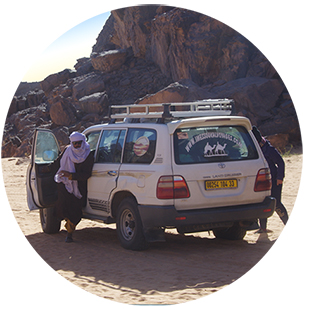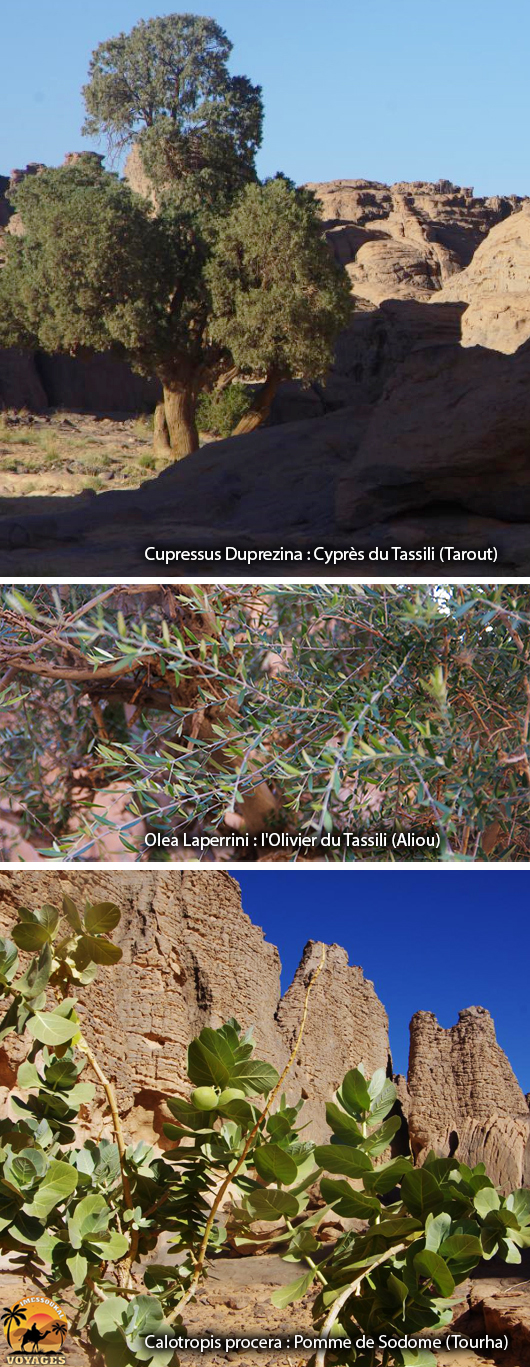OUR REGION
[Tassili nˈAjjer]

Located in the central Sahara, in the south-east of Algeria and more than 2000 km from the Mediterranean coast, the Tassili N'Azdjer Park extends over an area of more than 80,000 square kilometers.
(compared to that of Scotland which is 77,180 km2t that of Lebanon which is 10,400 km2). Tassili N'Azdjer ("Tassili", Tamahaq word, Berber language of the Tuareg, means "plateau" and
"Azdjer" refers to the tribe that lives there) is limited to the north by the ergs of Issaouen nˈIghargharen, nˈ Tifernine and Bougharet, to the west by Ahaggar, to the east by the Libyan borders and
to the south by those of Niger. Its altitude varies between 500 and 2200 meters. Tassili was established as a National Historic Monument in July 1972 and classified as a World Heritage Site by UNESO in 1982.
for its proven cultural riches, and admitted to the MAB network as a Man and Biosphere Reserve in 1986, due to the diversity and fragility of these ecosystems
natural. The Ihérir valley was listed, in February 2001, as a wetland of global interest on the list of the RAMSAR global wetland convention.
PHYSICAL APPEARANCE
On the physical level, Tassili N'Azdjer draws its originality from the uniformity of a powerful sandstone sedimentary series arranged in
fairly regular horizontal stacks.
A true living memory, these sandstones have kept intact the traces of major geological and climatic events: orogeny, glaciation,
volcanism, maritime transgressions and regressions, sedimentation, fluvial and wind erosion.
The gorges and canyons which cut into the Tassili plateaus are the two essential forms which control the morphological system of this mineral space.
The expanses of dunes or ergs which crown and envelop the Tassilian foothills, insinuating themselves into the smallest passages, are signs of an increasingly increasing aridity.
CLIMATE
Like the entire central Sahara, Tassili N'Azdjer experienced a climatic upheaval marked by a succession of humid phases (attested by a very developed hydrographic network,
gueltas, flora of Mediterranean origin and large fauna) and arid phases. The latter are characterized by rare and irregular rains which often fall under
forms of showers. The very contrasting temperatures and frequent winds accentuate evaporation.
The hydrographic network of Tassili is the result of large torrents which have dug rivers and canyons, which flow during floods, are most of the time dried up,
thus constituting penetration routes, particularly for nomads in search of pasture.

Life in the Tassilian ecosystems is frugal, due to the harsh climate. This arid character has only allowed a certain variety of life forms to occupy this immense area. These living beings were able to adapt and resist the austerity of the environment.
The flora and fauna of Tassili are the results of climatic variations which took place during the geological eras. The aridification of the climate has resulted in the decline of plant species of Mediterranean origin (of which a few examples remain) and the extinction of certain animal species (the existence of which is attested by rock art: rhinoceros, giraffe, elephant) and the installation of other species adapted to the xeric nature of the environment.
The current flora of Tassili belongs to the so-called Saharo-Arabic botanical region specific to the African desert to which are added Mediterranean and tropical elements.
The species of Mediterranean strains constitute almost half of Saharan endemism. The most important are the relic plants:
Cupressus Duprezina: Tassili Cypress (Tarout)
Myrtus Nivelli: Myrtle (Tafeltest)
Olea Laperrini : the olive tree of Tassili (Aliou)
Lavandula pubescens ssp antineae : lavender (Idjih)
The species of Saharo-Arabic strains are numerically important but not very diversified, characterized by Calligonum and Zygophyllaceae.
The species of tropical strains represent witnesses of a flora which was more extensive:
Acacia Raddiana: Acacia (Absagh)< br> Balanites aegyptiaca : Desert date palm (Teboureq)
Calotropis procera : Apple of Sodom (Tourha)
Salvadora persica : Toothpick (Tihaq)
The plant cover is mainly located in the spreading areas, of wadi beds and the edges of guelta. However, certain species also develop in the most hostile environments: cliffs, regs (flat and rocky areas) and ergs.
Animals live in symbiosis with vegetation which serves as fodder for some and feeds the prey of others. Among these species, the bighorn sheep people of steep areas, the fennec is located at the level of the ergs, the hyrax rocks colonize rocky areas and the gazelle, for its part, prefers open areas.
These innumerable natural resources have enabled man to flourish in these hostile immensities. This man knew how to adapt his lifestyle to the specificity and fragility of these ecosystems. They offered him food, condiments, fodder (for its livestock), raw materials for its habitat and its crafts, without forgetting the virtues of the species used by traditional healers.

Since prehistoric times, humans have lived in the Sahara. Their cultural testimonies date back several hundred years thousands of years. It is certainly admitted that the physical environment imposed on these first men lifestyles and forms of organization adapted with low technical capacities, which has not prevented them, throughout the long human evolution with the different relationships to environment, to construct and develop systems of representation of their environment. These men did not simply transform their environment; they interpreted it too.
The cultural wealth is exceptional and of a diversity which testifies to an intense and almost uninterrupted occupation of the space since prehistory.
More than 2 million years ago, in particularly humid conditions, the first humans settled in Tasssili N'Azdjer, around large lakes that are now dry. These men are bearers of a culture of arranged pebbles, the Oldowan, the one which announces human civilization.
Other vestiges of exceptional richness characterize another culture: the Acheulian, which extends between 1000,000 and 100,000 years ago. Its material consists of bifaces and cleavers, associated with a large Quaternary fauna of large mammals.
Thanks to fairly mild bioclimatic conditions, notably the existence of lakes, large populations settle in the Sahara, they carry a culture specifically North African: the Alterian culture which extends between 40,000 and 20,000 years ago. This culture is characterized by a lithic industry including all kinds of tools with a peduncle.
Between 20,000 and 10,000 years ago, a phase corresponding to the installation of very arid conditions, human occupation shrinks considerably and the possibilities of cultural production are almost reduced.
It was with the return of wetter conditions that a real population was established in the Sahara, which became aware of its power over the environment. This change of thinking is perceptible through a new technical mastery: breeding, agriculture, the invention of pottery, basketry, lithic material (arrow frames, polished axes, millstones, wheels and ceramics), stone sculptures, representing figurines (Rondes Bosses), ostrich egg tests and cave art; it is the Neolithic which spreads between 10,000 and 5,000 years ago.
Neolithic men felt the need and necessity to represent their world by engraving and painting on the walls of the ceilings of the shelters as well as on the slabs. floors.
They represented faunal elements, gestures and scenes of daily life as well as geometric and conceptual shapes. these works and witnesses rock iconographic images are translated at a higher stage of their evolution into writing by the development of characters with phonetic values, in this case writing Berber from where Tifinagh remains.
One of the most remarkable characteristics of Tassilian rock art is the great variety of subjects represented and styles that can be recognized on numerous sites.
From 5,000 years ago, Tassili experienced a strong expansion and variety of funerary and ritual monuments, during the protohistoric period, these are made up of different types and shapes of architectural structures: Tumulus, Bazinas, Alignments and Circles, grouped into real necropolises. others are often scattered not far from water points, centers of cultivation, valleys and rocky outcrops.
Funerary monuments are not only places of burial, but also places designed for rites and other funeral practices.
THE TASSILI NATIONAL PARK OFFICE
[ OPNT ]

The Tassili National Park Office [OPNT] was created in 1972, following the classification of the Park as
world historic monument. He is responsible for managing this protected space. The Office, whose administrative headquarters is located in Djanet, is a public establishment,
administrative character and with a cultural vocation, endowed with civil personality and financial autonomy. Administratively, the OPNT is represented by three
sub-directors located respectively in Djanet, Bordj El Houas and Illizi.
OPNT’S MISSIONS:
The missions of the Tassili National Park Office are: the protection, conservation and enhancement of the cultural and natural heritage of Tassili.
ITS INSTRUCTIONS AND RECOMMENDATIONS:
1. FOR YOUR SAFETY:
Access, circulation and visits inside the Tassili National Park are regulated. They give rise to the payment of access rights.
It is forbidden to travel alone outside the authorized roads and tracks. Any on-site visit should be done through an agency.
tourist approved by the State, or supervised by a conservation agent from the Tassili n'Azdjer National Park Office.
2. TO PRESERVE WATER:
Water resources in the Sahara are very limited and are decreasing due to aridity. Water is vital for
nomads and livestock, travelers and wild animals.
⇒ It is prohibited to camp near a water point.
⇒ It is forbidden to wash or bathe in the gueltas.
⇒ It is prohibited to use detergents and laundry detergents near the gueltas.
3. TO PRESERVE THE ENVIRONMENT:
⇒ It is prohibited to drain your vehicle near a water point or a natural or cultural site. drained oils must be recovered.
⇒ Don't forget to leave your bivouac location clean before your departure, by collecting rubbish, paper, plastics, cans of food, etc.
Bring trash bags and place them in a public dump when you return from the circuit.
4. TO PRESERVE THE PRIVACY OF POPULATIONS:
⇒ Respect local privacy, customs and way of life. human contact will only be more enriched.
5. TO PRESERVE NATURAL AND CULTURAL HERITAGE:
The ecological balance of Tassili is very fragile. Several fauna and flora species are protected by law.
Legislation relating to the Tassili National Park and the protection of cultural heritage prohibits:
⇒ destroy or collect minerals and fossils.
⇒ cut, mutilate, uproot and destroy uncultivated plants, including trees and shrubs.
⇒ capture, transport, hawk, sell and buy non-domestic animals, live or stuffed.
⇒ pursue animals with vehicles leading them to death by hyperthermia.
⇒ hunt with or without a firearm.
⇒ collect, hold, sell or buy any archaeological object.
⇒ carry out surveys and other excavations without authorization.
⇒ remove by any process whatsoever, wet, overload, scratch, inscribe graffiti, cut or damage the
engravings or cave paintings.
⇒ damage any prehistoric or historic archaeological site.
SOURCE: OPNT (Tassili National Park Office)